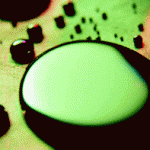
Converting mercury to its far more toxic organic form, methylmercury, doesn’t seem like the most intuitive detox strategy, but scientists suspect that this may be a defense for some microorganisms — albeit much to the detriment of the local ecosystems.
Global mercury pollution from mining and other industrial processes has provided a special group of microbes with the necessary ingredients to churn out the far more toxic methylmercury. These microorganisms can safely manage the toxin within their own cell walls; however, once outside, this potent neurotoxin becomes tenaciously lodged in the food chain all the way to the top, getting more concentrated as it goes. Consumption of contaminated fish is a leading source of mercury poisoning in humans, where it causes debilitating neurological disorders (as seen in the devastating incident in Minamata, Japan). It’s still a mystery why some microbes have evolved this ability, but researchers have spent the past several decades on the more pressing issues of tracking down which microorganisms are creating methylmercury, how they’re doing it, and where methylmercury is going to show up next.
In 2013, scientists made a leap forward by discovering the genetic fingerprint for mercury methylation: the hgcAB cluster. Using this genetic sequence as a tag, they have been sifting through genome collections from around the world to identify culprit microbes. Their initial survey showed that this ability was far more common than thought, with the potential for methylmercury production in unexpected and detrimental places like rice paddies, where it could contaminate an additional food supply.
Earlier this month, a more comprehensive study of 823 million gene sequences discovered yet more mercury-methylating species distributed worldwide across a variety of environments, with a particular predilection for oxygen-free settings. Of the sampled anaerobic environments, nearly all of them contained organisms with hqcAB, including sediments from lake bottoms, wetlands, and coastal “dead zones.” Reassuringly, the samples from anaerobic vertebrate (including human) guts were exceptions to this trend. Of particular note, there was high methylmercury-producing potential in the thawing permafrost soils of the Arctic, where air-borne mercury pollution tends to accumulate. This suggests that methylmercury could become increasingly problematic in the Arctic ecosystem as temperatures rise and microbes become more active.
In addition to identifying the sources and localization of methylmercury creation, these results will also help scientists to understand how and why this capability evolved in the first place.

Image credits:
“Mercury Element”. Licensed under Public Domain via Wikimedia Commons – https://commons.wikimedia.org/wiki/File:Mercury_Element.gif#/media/File:Mercury_Element.gif
By Bretwood Higman, Ground Truth Trekking. [CC BY 3.0 (http://creativecommons.org/licenses/by/3.0)], via Wikimedia Commons
https://commons.wikimedia.org/wiki/File%3AMercuryFoodChain-01.png

